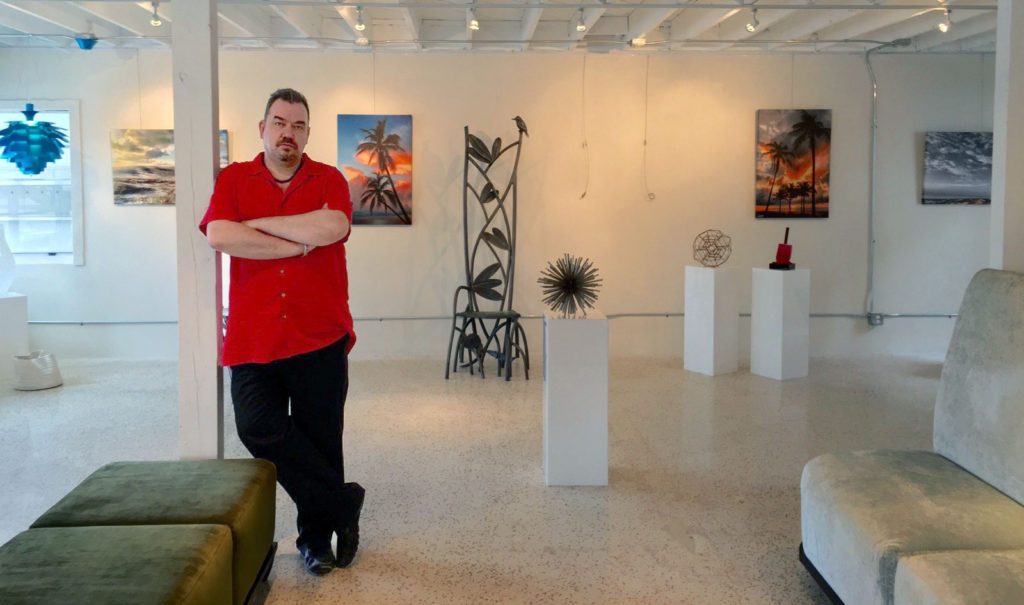Photographer, artist and iPhoneography pioneer Andy Royston considers the wisdom of sharing his art online and the trials and tribulations of the mobile artist (those who create art and photography entirely on mobile and cellular devices).
Today, I found a bricks-and-mortar business was using a familiar image to promote an art gallery exhibit. Three artists were featured in the show, yet there was something all too familiar about the image. It was my own.
This is not the first time that I’ve found one of my images pilfered and used out of context, uncredited and unrecognized.
I suppose it’s my own damn fault. I create images of tropical scenes that could be taken on a hundred different beaches, so it is quite understandable that that folks might find my efforts indistinguishable from another. After all, you’ve seen one palm tree and crashing wave you’ve seen ’em all, right?
Art professionals have told me that by sharing my work online through social media I am diminishing its worth to art collectors and galleries. It might be argued that by sharing I am in effect giving my art away, and that, buddy, is not how it’s done.
Indeed the art gallery who used my image wrote a disclaimer, a kind of back-handed apology, saying that, because it was found on a Google image search, they consider it a public domain image. They made what they call a ‘concerted effort’ to find ‘the artist’, but,hey, decided to use it anyway.
It could be that, because the gallery made a reasonably diligent search for the owner of the artwork it can be considered an orphan work in some circles. A good faith search for half an hour on google should be enough, right? I know that they say that making use of a copyrighted work without permission puts the thief on the hook for $150,000 per work, how can an artist ever be able to make that stick? This is an age where everything is free and clear and public domain, right?
Besides, what have I, the artist, actually lost by this gallery using my art to promote an unconnected exhibition. It’s not like a piece of art stolen from the shelves. It’s just a reproduction, so the most I might lose is a nominal reproduction rights fee, of say, two hundred dollars.
But here’s the catch. If the user had known that the work was copyright they wouldn’t have paid the fee, as they didn’t have the budget. So I wouldn’t have been paid anyway, right? Besides, copying isn’t stealing. In reproducing an image I am not diminishing the original. And it’s on Google, dude, get over it. Lie back and think of the exposure!
The Value of Mobile Art
My way of creating and representing my art has always been online.
My images of the shore are at their most relevant and powerful and meaningful when they reach their audience within minutes of creation. This in my eyes is fresh photography, as close a representation of the moment as I can muster. Each image is made right at the shore in front of the scenes I represent, uploaded while my iPhone is still wet!
Sharing is an integral part of my art – it is spontaneous, instinctive and free of expectation. The reaction of followers and the interaction that it inspires of all a part of the work. To me, and I suspect the millions of people who share their images via Instagram, Snapchat, Facebook or whatever your social media poison – this is easy to understand and appreciate.
So why is it taking so long for the art world to get behind this art form, now close to a decade old?
There is so much for critics to get excited about – the fact that the first wave of mobile art and photography pioneers all made contact globally and tipped each other off about Apple store initiatives and mobile photography showings. The second wave came in on the Instagram tsunami and opened up the shoot and share ethos to a generation. A generation to whom photography is just a part of every day social life. If there isn’t a photo it isn’t real.

Anne’s Beach
Surely now it’s time for art collectors and galleries to step back from deconstructing the toy box, the Disney characters and barbie dolls on graffiti backdrops, the digital dada and the “me-too” surrealism, and embrace a whole new art world. One where the gallery is global and whose artists create and share and interact every single day.
Yes, I know that the art world loves nothing more than the one-of-a-kind ‘thing’, something physical and tangible that you can own and hang on the wall. The mobile art world, where artists use their social media world as their primary exhibition space, has not only left gallery owners and curators behind, it has also meant that the finest artists in the field are still largely unknown to the serious art collector.
A good friend and iPhone art pioneer, the late great Jaime Ferreyros, was notably circumspect about sharing his work online, preferring to keep his work off the internet. It paid off to a great extent. Jaime made serious inroads into the mainstream Miami art scene, and with the support of enlightened galleries and promotors like Noor Blazekovic of Irreversible was building a giant reputation for his mobile art. It was so encouraging to see his creations at Art Basle and other prestige shows. It gave encouragement to all of us still working in the mobile media that our work is being seen, respected and collected.
The biggest problem that online artists face is the devaluation of the shared image. As my friends at the gallery down the road have told me, the consensus is that anything found online is public domain and therefore worthless.
How on earth can mobile artists achieve a profitable artistic portfolio when even art galleries cannot see the value in a shared image. Will my art only mean anything to the art world if I stop sharing altogether and start printing precious limited editions, hawking them around art shows and galleries like a street vendor? I have to create product?
Personally I’m as far from making that choice as I ever have been. My gallery remains online, and the share is part of the process. I know that my work prints well and looks wonderful on canvas, yet it remains at odds with my artistic process.
Perhaps one day I’ll step back and realize that I’ve been giving away my art for the better part of a decade and everything I have shared has no monetary value whatsoever. For this reason alone I’ll never make so much as a ding on the shiny chrome of the mainstream art scene. I hope that’s not true.
Andy Royston’s work is currently on show at Fort Lauderdale’s North Beach Design For More information about visiting click here. For more information about North Beach Village Design, call (954) 565-5790 or visit bit.ly/villagedesign.
Follow Andy’s work at Twitter, Instagram and Flickr
ABOUT THE AUTHOR







